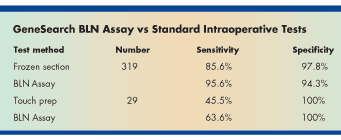New Way to Test Lymph Nodes Intraoperatively
An investigational gene-based diagnostic assessment for lymph node metastases may improve intraoperative pathology and surgical decision-making, and reduce the need for second axillary node surgeries
• SAN ANTONIOAn investigational gene-based diagnostic assessment for lymph node metastases may improve intraoperative pathology and surgical decision-making, and reduce the need for second axillary node surgeries, according to a large multicenter study presented at the 29th Annual San Antonio Breast Cancer Symposium (abstract 28).
The GeneSearch Breast Lymph Node (BLN) Assay (Veridex, LLC) was found to be 10% to 18% more sensitive than frozen section or touch preparation, the traditional intraoperative methods of detecting metastases, reported Peter W. Blumencranz, MD, medical director of Moffitt Morton Plant Cancer Care, Clearwater, Florida.
The BLN Assay is a rapid closed-tube system using predetermined cut-off points for cytokeratin-19 and mammaglobin that allow it to identify metastases greater than 0.2 mm. It can be performed by a technician with minimal training and thus free up the pathologists' time. It is objective and standardized, providing a "yes or no" response for the presence of metastases, and multiple nodes can be assessed in a single run.
Results of the assay can typically be reported during the operation within 30 to 40 minutes from the time the sentinel node is removed, Dr. Blumencranz said. The test outcomes are intended to be used to guide the decision to excise additional lymph nodes and to aid in staging.

Importantly, he said, the BLN Assay samples 50% of the node, compared with less than 5% with standard approaches. "With permanent section HE, the actual tissue viewed is only 2% to 5% of the node. This will miss 10% to 15% of clinically relevant metastases," Dr. Blumencranz commented.
Head-to-Head Comparisons
In the study involving 416 patients across 11 clinical sites, fresh sentinel lymph node tissue was tested using the BLN Assay and current methods for lymph node assessmentfrozen section (319 samples) or touch preparation cytology (29 samples).
All nodes were sampled for permanent section HE, and most were also sampled for immunohistochemistry. The results from all the tests were compared to permanent section histology results to determine the performance of each method. Positive histology was found on 29% of the samples.
In the comparison with frozen section, the overall sensitivity of the BLN Assay was 95.6% vs 85.6% for frozen section. Overall specificity was 94.3% and 97.8%, respectively. In a comparison with touch prep, the overall sensitivity of the BLN Assay was 18% higher, while specificity was 100% for both methods.
Macrometastases were identified in 97.4% of samples with BLN, compared with 90.6% with frozen section; micrometastases were identified in 68.2% and 40.9%, respectively. BLN also greatly outperformed touch prep in detecting metastases. "Naturally, this assay is going to be better able to pick up micrometastases looking at a whole piece of tissue, rather than just limited samples," he said.
Another point of interest, Dr. Blumencranz said, is that lobular invasive cancer is hard to pick up on frozen section. In patients with invasive lobular tumors, the BLN Assay detected 91.3% of metastases vs 65.2% by frozen section.
Compared with permanent section histology, the gold standard, sensitivity for the detection of both micrometastases and macrometastases was markedly improved with the BLN Assay. Compared with touch prep cytology, the differences were even more impressive, Dr. Blumencranz concluded.
The "down side" to BLN, he said, is a slightly higher false-positive rate5.8% compared with 2.2% with frozen sectionhowever, this can be explained by the larger magnitude of tissue sampled. "More sampling discrepancies are expected when more tissue is sampled," Dr. Blumencranz noted.
He concluded that the BLN Assay "can raise the standard of care for intraoperative node assessment. It is rapid, with better sensitivity than current methods. It is objective and reproducible, and most labs can adopt the method with minimal training. It can be run by trained personnel, which can reduce the burden on your expert pathologist."
More node sampling, he said, should yield better truth in nodal staging. "Most important," he said, "it reduces secondary surgeries on the axillae, surgeries that increase cost, create time and scheduling problems, and add to patient anxiety."